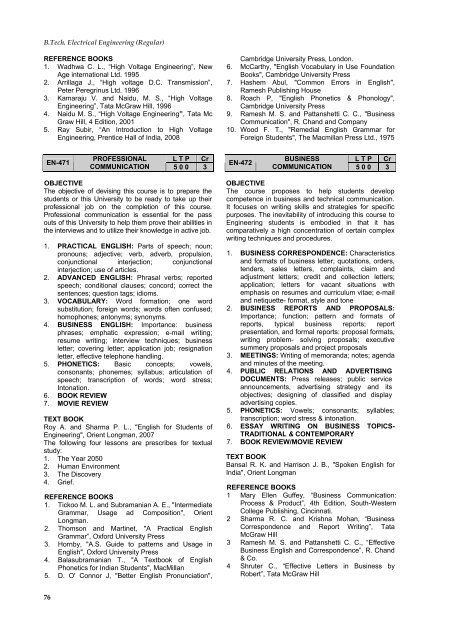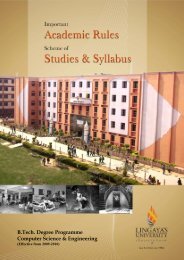B.<strong>Tech</strong>. <strong>Electrical</strong> <strong>Engineering</strong> (Regular)REFERENCE BOOKS1. Wadhwa C. L., “High Voltage <strong>Engineering</strong>”, NewAge international Ltd. 19952. Arrillaga J., “High voltage D.C. Transmission”,Peter Peregrinus Ltd. 19963. Kamaraju V. and Naidu, M. S., “High Voltage<strong>Engineering</strong>”, Tata McGraw Hill, 19964. Naidu M. S., “High Voltage <strong>Engineering</strong>”, Tata McGraw Hill, 4 Edition, 20015. Ray Subir, “An Introduction to High Voltage<strong>Engineering</strong>, Prentice Hall of India, 2008Cambridge University Press, London.6. McCarthy, "English Vocabulary in Use FoundationBooks", Cambridge University Press7. Hashem Abul, "Common Errors in English",Ramesh Publishing House8. Roach P, "English Phonetics & Phonology",Cambridge University Press9. Ramesh M. S. and Pattanshetti C. C., "BusinessCommunication", R. Chand and Company10. Wood F. T., "Remedial English Grammar forForeign Students", The Macmillan Press Ltd., 1975EN-471PROFESSIONAL L T P CrCOMMUNICATION 5 0 0 3EN-472BUSINESSL T P CrCOMMUNICATION 5 0 0 3OBJECTIVEThe objective of devising this course is to prepare thestudents or this University to be ready to take up theirprofessional job on the completion of this course.Professional communication is essential for the passouts of this University to help them prove their abilities inthe interviews and to utilize their knowledge in active job.1. PRACTICAL ENGLISH: Parts of speech; noun;pronouns; adjective; verb, adverb, propulsion,conjunctional interjection; conjunctionalinterjection; use of articles.2. ADVANCED ENGLISH: Phrasal verbs; reportedspeech; conditional clauses; concord; correct thesentences; question tags; idioms.3. VOCABULARY: Word formation; one wordsubstitution; foreign words; words often confused;homophones; antonyms; synonyms.4. BUSINESS ENGLISH: Importance: businessphrases; emphatic expression; e-mail writing;resume writing; interview techniques; businessletter; covering letter; application job; resignationletter, effective telephone handling.5. PHONETICS: Basic concepts; vowels,consonants; phonemes; syllabus; articulation ofspeech; transcription of words; word stress;Intonation.6. BOOK REVIEW7. MOVIE REVIEWTEXT BOOKRoy A. and Sharma P. L., "English for Students of<strong>Engineering</strong>", Orient Longman, 2007The following four lessons are prescribes for textualstudy:1. The Year 20502. Human Environment3. The Discovery4. Grief.REFERENCE BOOKS1. Tickoo M. L. and Subramanian A. E., "IntermediateGrammar, Usage ad Composition", OrientLongman.2. Thomson and Martinet, "A Practical EnglishGrammar”, Oxford University Press3. Hornby, "A.S. Guide to patterns and Usage inEnglish", Oxford University Press4. Balasubramanian T., "A Textbook of EnglishPhonetics for Indian Students", MacMillan5. D. O' Connor J, "Better English Pronunciation",OBJECTIVEThe course proposes to help students developcompetence in business and technical communication.It focuses on writing skills and strategies for specificpurposes. The inevitability of introducing this course to<strong>Engineering</strong> students is embodied in that it hascomparatively a high concentration of certain complexwriting techniques and procedures.1. BUSINESS CORRESPONDENCE: Characteristicsand formats of business letter; quotations, orders,tenders, sales letters, complaints, claim andadjustment letters; credit and collection letters;application; letters for vacant situations withemphasis on resumes and curriculum vitae; e-mailand netiquette- format, style and tone2. BUSINESS REPORTS AND PROPOSALS:Importance; function; pattern and formats ofreports, typical business reports; reportpresentation, and formal reports: proposal formats,writing problem- solving proposals; executivesummery proposals and project proposals3. MEETINGS: Writing of memoranda; notes; agendaand minutes of the meeting.4. PUBLIC RELATIONS AND ADVERTISINGDOCUMENTS: Press releases; public serviceannouncements, advertising strategy and itsobjectives; designing of classified and displayadvertising copies.5. PHONETICS: Vowels; consonants; syllables;transcription; word stress & intonation.6. ESSAY WRITING ON BUSINESS TOPICS-TRADITIONAL & CONTEMPORARY7. BOOK REVIEW/MOVIE REVIEWTEXT BOOKBansal R. K. and Harrison J. B., "Spoken English forIndia", Orient LongmanREFERENCE BOOKS1 Mary Ellen Guffey, “Business Communication:Process & Product”, 4th Edition, South-WesternCollege Publishing, Cincinnati.2 Sharma R. C. and Krishna Mohan, “BusinessCorrespondence and Report Writing”, TataMcGraw Hill3 Ramesh M. S. and Pattanshetti C. C., “EffectiveBusiness English and Correspondence”, R. Chand& Co.4 Shruter C., “Effective Letters in Business byRobert”, Tata McGraw Hill76
Lingaya’s University, Faridabad5 Wing F. W. and Anncree D., “English BusinessLetters”, Orient Longman.6 Sarah Freeman, “Written Communication inEnglish”, Orient Longman.7 Leo Jones and Riched Alexander, “InternationalBusiness English”, Cambridge University Press8 Sweet Stephen, “General and Business English”,Sir Issac Pitman & Sons Ltd., London.9 Charles FI. Sides, “How to Write and Present<strong>Tech</strong>nical Information”, Cambridge UniversityPress10 Susan Stevenson/Stave Whitmore, “Strategies for<strong>Engineering</strong> Communication”, John Wiley andSons/Replika Press. Pvt. Ltd. Delhi.IT-423INTRODUCTION TO L T P CrE-COMMERCE & ERP 5 0 0 3OBJECTIVETo provide knowledge about the protocols, methods,security issues in electronic commerce as well as aboutenterprise resource planning tools, models andtechniquesPRE-REQUISITESKnowledge of internet and web development, datamining, computer networks, software engineeringPART A1. INTRODUCTION AND CONCEPTS: Networks andcommercial transactions – Internet and othernovelties, networks and electronic transactionstoday; model for commercial transactions; Internetenvironment – internet advantage; world wide weband other internet sales venues; online commercesolutions.2. ELECTRONIC PAYMENT METHODS: Updatingtraditional transactions, secure online transactionmodels; online commercial environments; digitalcurrencies and payment systems; offline secureprocessing; private data networks; securityprotocols; electronic payment systems: digitalpayment systems3. DIGITAL CURRENCIES: Operational process ofDigicash; Ecash Trail; Using Ecash; Smart cards;Electronic Data Interchange: basics, EDI versusInternet and EDI over Internet; Strategies,<strong>Tech</strong>niques and Tools; Shopping techniques andonline selling techniques.PART B4. ERP- AN ENTERPRISE PERSPECTIVE:Production Finance, Personnel disciplines andtheir relationship, Transiting environment, MISIntegration for disciplines, Information/Workflow,Network Structure, Client Server IntegratorSystem, Virtual Enterprise.5. ERP – RESOURCE MANAGEMENTPERSPECTIVE: Functional and Process ofResource; Management; Introduction to basicmodules of ERP System: HRD, Personnelmanagement, training and development; skillinventory, material planning and control, inventory;forecasting; manufacturing; production planning;production scheduling; production control; salesand distribution; finance; resource management inglobal scenario.6. ERP - INFORMATION SYSTEM PERSPECTIVE:Introduction to OLAP (Online Analysis andProcessing), TP, OAS, KBS, MRP, BPR, SCM,REP, CRM, Information Communication<strong>Tech</strong>nology.7. ERP-KEY MANAGERIAL ISSUES: ConceptSelling; IT infrastructure; implication of ERPsystems on business organization; critical successfactors in ERP System; ERP Cultureimplementation issues; resistance to change; ERPselection issues; return on investment; pre andpost implementation issues.TEXT BOOKRavi Kalakota and Whinston Andrew, “Frontiers ofElectronic Commerce”, Addison Wesley, 1996REFERENCE BOOKS1. V. K. Garg and N. K. Venkita Krishna, “EnterpriseResource Planning – Concepts and Practice”,Prentice Hall of India, 1998,2. Motiwala, “Enterprise Resource & Planning”, 1stedition, Pearson Education3. John Antonio, Fernandez, “The SAP/3 Handbook”,Tata McGraw Hill4. Denial Amor, “The E-Business Revolution”,Addison Wesley5. Sokol, “From EDI to E-Commerce: A BusinessInitiative”, Tata McGraw Hill6. Greenstein and Feinman, “E Commerce”, TataMcGraw Hill7. Rajan and Nag, “E Commerce: The Cutting Edgeof Business”, Tata McGraw Hill8. Jaffrey F. Rayport , Bernard J. Jaworski, “E-Commerces”, Tata McGraw Hill, 20029. Greenstein and Feinman, “Electronic Commerce –Security, Risk Management and Control”, TataMcGraw Hill, 200210. Hendry Chan, Raymond Lee, Tharam Dillon andEllizabeth Cang, “E-Commerce Fundamentals andApplications”, John Wiley.11. Efraim Turbon, Jee Lee, David King, H. MichaelChang, “E-Commerce” Wiley VCH, 2004WEB REFERENCES1. www.exforsys.com/tutorials/erp/erp-and-ecommerce.html2. www.bizautomation.com3. itmanagement.earthweb.com/erp4. www.e2-llc.com/e2_ecommerce_erp.aspx5. e-comm.webopedia.com/TERM/e/ERP.htmlINFORMATION STORAGE & L T P CrIT-443MANAGEMENT 5 0 0 3OBJECTIVEUsing a “building block” approach, the ISM curriculumprovides a core understanding of storage technologiesand progresses into system architectures, introductionto networked storage, and introduction to informationavailability. The course provides a comprehensiveintroduction to data storage technology fundamentals.Students will gain knowledge of the core logical andphysical components that make up a storage systemsinfrastructure.77
- Page 1 and 2:
B.Tech. Degree ProgrammeElectrical
- Page 5 and 6:
Lingaya’s University, FaridabadAB
- Page 7 and 8:
IMPORTANT ACADEMIC RULESB.Tech. Deg
- Page 9 and 10:
Lingaya’s University, Faridabadac
- Page 11 and 12:
Lingaya’s University, FaridabadSe
- Page 13 and 14:
Lingaya’s University, FaridabadIn
- Page 15 and 16:
CATEGORY-WISE LIST OF COURSESLingay
- Page 17 and 18:
Lingaya’s University, FaridabadSU
- Page 19 and 20:
Lingaya’s University, FaridabadSc
- Page 22 and 23:
B.Tech. Electrical Engineering (Reg
- Page 24 and 25:
B.Tech. Electrical Engineering (Reg
- Page 26 and 27:
B.Tech. Electrical Engineering (Reg
- Page 28 and 29:
B.Tech. Electrical Engineering (Reg
- Page 30 and 31: B.Tech. Electrical Engineering (Reg
- Page 32 and 33: B.Tech. Electrical Engineering (Reg
- Page 34 and 35: B.Tech. Electrical Engineering (Reg
- Page 36 and 37: B.Tech. Electrical Engineering (Reg
- Page 38 and 39: B.Tech. Electrical Engineering (Reg
- Page 40 and 41: B.Tech. Electrical Engineering (Reg
- Page 42 and 43: B.Tech. Electrical Engineering (Reg
- Page 44 and 45: B.Tech. Electrical Engineering (Reg
- Page 46 and 47: B.Tech. Electrical Engineering (Reg
- Page 48 and 49: B.Tech. Electrical Engineering (Reg
- Page 50 and 51: B.Tech. Electrical Engineering (Reg
- Page 52 and 53: B.Tech. Electrical Engineering (Reg
- Page 54 and 55: B.Tech. Electrical Engineering (Reg
- Page 56 and 57: B.Tech. Electrical Engineering (Reg
- Page 58 and 59: B.Tech. Electrical Engineering (Reg
- Page 60 and 61: B.Tech. Electrical Engineering (Reg
- Page 62 and 63: B.Tech. Electrical Engineering (Reg
- Page 64 and 65: B.Tech. Electrical Engineering (Reg
- Page 66 and 67: B.Tech. Electrical Engineering (Reg
- Page 68 and 69: B.Tech. Electrical Engineering (Reg
- Page 71 and 72: OPEN ELECTIVELingaya’s University
- Page 73 and 74: Lingaya’s University, Faridabadch
- Page 75 and 76: Lingaya’s University, Faridabad4
- Page 77 and 78: Lingaya’s University, Faridabad6.
- Page 79: Lingaya’s University, FaridabadEL
- Page 83 and 84: Lingaya’s University, Faridabador
- Page 85 and 86: Lingaya’s University, Faridabad4.
- Page 87: Lingaya’s University, Faridabad83
















